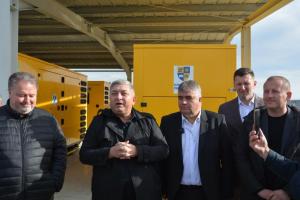Green Energy from Waste: The First Molecular Disintegration Plant Is Operating in Transylvania
Cluj is the first county in Romania to find a solution to reduce the amount of waste that needs to be landfilled after sorting recyclable materials.
Green energy is produced from the last fraction of sorted waste, which would normally end up in a landfill, where it would remain for thousands of years after being covered with soil.”
CLUJ-NAPOCA, TRANSYLVANIA, ROMANIA, November 1, 2025 /EINPresswire.com/ -- The Cluj County Council (Transylvania, northwestern Romania) has started producing electricity from waste. This is possible thanks to a molecular waste decomposition station invented by a graduate of the Faculty of Chemistry at Babeș-Bolyai University, who became an entrepreneur. Basically, the waste is heated to extremely high temperatures in the absence of oxygen. It decomposes into gases and ash. The gases are burned and produce electricity.— Vákár István, vice president of the Cluj County Council
Cluj is the first county to find a solution to reduce the amount of waste that needs to be landfilled after sorting recyclable materials. With an investment of €12 million, the first molecular disintegration plant was built, based on a Romanian invention, says Alin Tișe, president of the Cluj County Council. "In addition to electricity, the plant will also produce other components that we will capitalize on. The remaining ash will be used to make carbon filters, which will be used to filter the leachate produced by the waste cell. Also, the gas produced here will be used to power the osmosis station, which also manages the leachate and will turn it into distilled water. In other words, we will recover almost everything we produce from waste. The fraction you see is the last fraction after the waste has been sorted. We will have a capacity to look ahead to approximately 60,000 tons in the future, from which we will be able to produce approximately 56,000 MW per year," said Alin Tișe.
Most of the equipment was manufactured in Romania, mainly by companies in Cluj and Bucharest, says inventor Szakács János. "More than 85% of the money invested by the Cluj County Council remained in Romania. I hope to see the same thing happen with other investments," said the businessman, founder of Waste Powertech.
The new molecular disintegration plant will produce an amount of energy equivalent to the annual consumption of a city, says Vákár István, vice president of the Cluj County Council. "Green energy is produced from the last fraction of sorted waste, which would normally end up in a landfill, where it would remain for thousands of years after being covered with soil. Here, green energy is obtained, which is completely non-polluting, and from what measurements have been made, this investment is profitable. It can produce as much electricity as a city like Câmpia Turzii or Dej, two cities in central Transylvania, would consume," added Vákár István.
In the first stage, County Council representatives estimate that, initially, the green energy produced over a year, amounting to 24,576 MWh, will be able to fully cover the electricity consumption of the administrative forum, the Cluj Arena stadium, the airport, and other subordinate institutions, including the Tetarom Industrial Parks, Someș Water Company, etc. The production capacity of the waste molecular disintegration plant will increase to 56,000 MW/year after a new reactor is put into operation. It will start operating once the electricity company manages to increase the capacity to take over the energy produced at the Cluj waste ramp next year.
Initially, the molecular waste disintegration station has an initial processing capacity of approximately 25,000 tons of residual waste per year. In the coming period, the processing capacity will be increased to approximately 60,000 tons of residual waste per year, which exceeds the amount of waste produced annually in Cluj County and which remains after sorting recyclable materials and mechanical-biological treatment. In this way, the waste currently stored in the first cell of the Integrated Waste Management Center and that in the temporary landfill managed by the Cluj-Napoca City Hall will also be recovered. In the future, this molecular disintegration station will also be able to take waste produced in other regions of Romania.
The new, fully automated waste disintegration station operates within the Integrated Waste Management Center in Cluj County. Waste currently stored in the first cell of the Integrated Waste Management Center and waste stored in the temporary landfill managed by the Cluj-Napoca City Hall will also be recycled. Cluj-Napoca is Romania's second largest urban center after the capital Bucharest. It is the historical capital of Transylvania.
PADUREAN BIANCA CLUJ TODAY PRESS
Cluj Today Press SRL
email us here
The plant inauguration
Legal Disclaimer:
EIN Presswire provides this news content "as is" without warranty of any kind. We do not accept any responsibility or liability for the accuracy, content, images, videos, licenses, completeness, legality, or reliability of the information contained in this article. If you have any complaints or copyright issues related to this article, kindly contact the author above.



